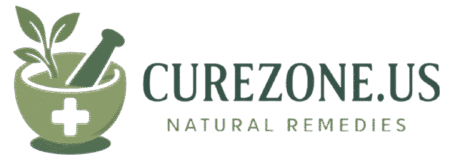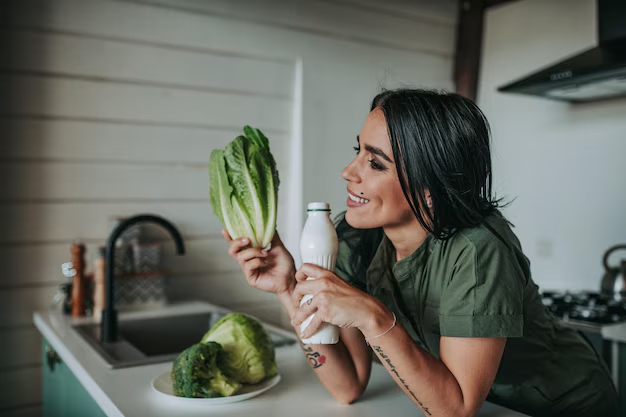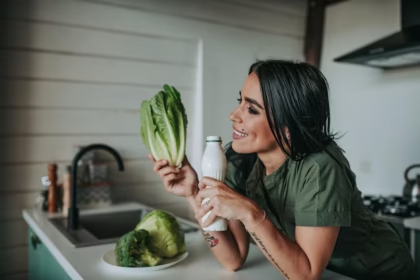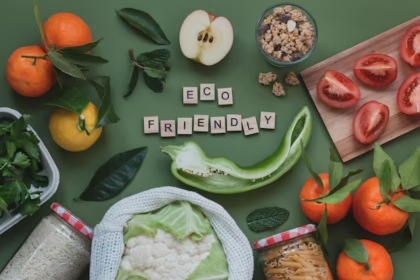A healthier lifestyle starts here.
Welcome! If you’re looking to boost your health and wellbeing, you’ve come to the right place. This organic grocery shopping guide is your roadmap to making smart food choices. We’ll break down everything you need to know to navigate the organic aisles with confidence, save money, and build a healthier lifestyle. Let’s dive in!
Organic food is grown without synthetic pesticides, herbicides, or fertilizers. This means fewer chemicals entering your body and our environment. Choosing organic also often supports farming practices that promote soil health, biodiversity, and animal welfare. While organic food can sometimes be more expensive, it’s an investment in your health and a step towards a more sustainable future.
| Why Choose Organic? |
Let’s explore why making the switch to organic might be the best decision for you and your family.
- Reduced Exposure to Harmful Chemicals: Conventional farming uses a lot of synthetic pesticides. These chemicals can end up on the food we eat and in the water we drink. Organic farming avoids these synthetic substances.
- More Nutritious Food: Some studies show that organic produce has higher levels of certain nutrients, like antioxidants, compared to conventionally grown food. Although this is still a debated topic, many believe the difference is worth it.
- Better for the Environment: Organic farming is kinder to the planet. It helps to improve soil health, reduce pollution, and conserve water. It also promotes biodiversity, which is important for a healthy ecosystem.
- Supports Sustainable Farming: When you buy organic, you are supporting farmers who are committed to sustainable practices. These farmers prioritize the health of the land and the well-being of their animals.
- No Genetically Modified Organisms (GMOs): Organic food cannot be genetically modified. If you want to avoid GMOs, choosing organic is a safe bet.
| Understanding Organic Labels |
Navigating the labels at the grocery store can be confusing. Here’s a simple breakdown of the different organic labels you might encounter:
- “100% Organic” indicates that the product is entirely made of organic materials.
- “Organic”: indicates that a product contains at least 95% certified organic ingredients, excluding water and salt.
- “Made with Organic Ingredients”: means the product contains at least 70% certified organic ingredients.
- “Certified Naturally Grown”: This label indicates the produce adheres to organic practices, but the farm isn’t certified by the USDA. Still a good option from local farms.
Always look for the USDA Organic seal. This is your assurance that the product meets strict organic standards. It also means that a certifying agency has inspected the farm or processing facility to ensure they are following the rules. Avoid products that just say “natural” as this term is not regulated and doesn’t guarantee anything about how the food was produced.
| What to Buy Organic (and What You Can Skip) |
Buying everything organic can get expensive. Here’s a guide to help you prioritize your organic purchases. The Environmental Working Group (EWG) releases two helpful lists each year: the Dirty Dozen and the Clean Fifteen.
The Dirty Dozen: These are the 12 fruits and vegetables that tend to have the highest levels of pesticide residue. Whenever possible, opt to buy these items organic. Here’s the list:
- Strawberries
- Spinach
- Kale, Collard Greens, Mustard Greens
- Peaches
- Pears
- Nectarines
- Grapes
- Apples
- Bell Peppers and Hot Peppers
- Cherries
- Blueberries
- Green Beans
The Clean Fifteen refers to 15 fruits and veggies that usually contain the least amount of pesticide residue. You can usually buy these conventionally without much concern. Here’s the list:
- Avocados
- Sweet Corn
- Pineapple
- Onions
- Papaya
- Sweet Peas (Frozen)
- Asparagus
- Honeydew Melon
- Kiwi
- Cabbage
- Watermelon
- Mushrooms
- Mangoes
- Sweet Potatoes
- Carrots
Remember, these lists are a guide. If you’re able to buy everything organic, that’s fantastic! But if you’re on a budget, focus on buying the Dirty Dozen organic.
| Beyond Produce: Other Organic Essentials |
Organic isn’t just about fruits and vegetables. Here’s what else you should consider buying organic:
- Dairy: Organic milk, yogurt, cheese, and butter come from cows that are raised without antibiotics, synthetic hormones, or GMO feed. The milk is often richer in omega-3 fatty acids.
- Meat & Poultry: Organic meat and poultry come from animals that are raised on organic feed, without antibiotics or synthetic hormones, and with access to the outdoors. Look for certifications that guarantee animals were treated humanely.
- Eggs: Organic eggs come from hens that are fed organic feed and have access to the outdoors. They are not given antibiotics or hormones.
- Grains: Organic grains—such as oats, rice, quinoa, and wheat—are grown without synthetic pesticides or herbicides. They’re a great source of fiber and nutrients.
- Processed Foods: Look for organic versions of your favorite processed foods, like pasta sauce, cereal, bread, and snacks. Just because something is organic doesn’t automatically make it healthy, so always read the label.
- Coffee & Tea: Coffee and tea plants are often heavily sprayed with pesticides. Choosing organic coffee and tea can reduce your exposure to these chemicals. Plus, organic coffee often tastes better!
| Tips for Saving Money on Organic Groceries |
Going organic doesn’t have to break the bank. Here are some tips for saving money:
- Buy in Season:
Produce that’s in season is not only tastier but also easier on your wallet. Visit your local farmers market or grocery store to find what’s fresh right now. - Shop at Farmers Markets: Farmers markets often offer organic produce at lower prices than grocery stores. You’re also supporting local farmers.
- Join a CSA: A Community Supported Agriculture (CSA) program allows you to buy a share of a local farm’s harvest. You’ll get fresh, seasonal produce at a discounted price.
- Buy in Bulk: Buying organic grains, nuts, and seeds in bulk can save you money. Store them in airtight containers to maintain freshness.
- Cook from Scratch: Processed organic foods can be expensive. Cooking from scratch gives you control over the ingredients and helps you save money. Prepare meals ahead of time to avoid the temptation of fast food.
- Grow Your Own: Start a small organic garden and grow your own herbs, vegetables, and fruits. Even a small container garden can make a difference.
- Compare Prices: Check prices at different stores and online retailers to find the best deals. Look for sales and discounts.
- Use Coupons: Many organic brands offer coupons online or in newspapers. Sign up for email lists to get exclusive deals and discounts.
- Buy Frozen: Frozen organic fruits and vegetables are often more affordable than fresh ones and retain just as much nutrition.
- Plan Your Meals: Planning your meals ahead of time helps you avoid impulse purchases and reduces food waste.
- Focus on Whole Foods: Prioritize buying whole, unprocessed foods over packaged snacks and convenience items. Whole foods are generally more affordable and healthier.
- Consider Store Brands: Many grocery stores offer their own organic store brands, which are often cheaper than name brands.
- Reduce Food Waste: Use leftovers creatively and compost food scraps to reduce waste and save money.
| Decoding Food Labels: Beyond Organic |
While focusing on organic is a great start, other food labels can provide additional information and guide your purchasing decisions:
- Non-GMO Project Verified: This label indicates that a product has been verified to not contain genetically modified organisms (GMOs). This is important because organic products are, by definition, non-GMO.
- Fair Trade Certified: This label guarantees that farmers and workers in developing countries receive fair wages and work under safe conditions, while promoting sustainable farming and community growth.
- Certified Humane: This label indicates that animals were raised with humane treatment, including access to the outdoors, space to move, and no antibiotics or hormones.
- Grass-Fed: This label means that animals were primarily fed grass, which is their natural diet. Grass-fed beef is typically leaner and contains higher levels of omega-3 fatty acids.
- Pasture-Raised: This label indicates that animals were raised on pasture, with access to fresh air and sunshine. Pasture-raised eggs are often richer in vitamins and minerals.
- Gluten-Free: This label indicates that a product does not contain gluten, a protein found in wheat, barley, and rye. It’s important for people with celiac disease or gluten sensitivity.
- Vegan: This label means that a product does not contain any animal products, including meat, dairy, eggs, or honey. It’s important for people following a vegan diet.
Knowing what these labels mean can help you make informed choices and align your purchases with your values.
| Organic Certification Process Becoming a certified organic operation involves a rigorous process.Here’s a simplified view:Application: Farm or business submits an application.Review: Certifying agent reviews the application.Inspection: On-site inspection to verify practices.Decision: Certifying agent decides whether to grant certification.Annual Review: Certified operations undergo annual reviews.This process ensures compliance with USDA organic standards. | Understanding ‘Natural’ vs. ‘Organic’It’s critical to distinguish between these terms.‘Natural’: No legal definition, often misleading.‘Organic’: Strict USDA standards, requires certification.Don’t be fooled by the term ‘natural’. Always look for the USDA Organic seal for assurance. |
| Making the Transition: A Step-by-Step Guide |
Switching to organic may feel overwhelming at first, but it doesn’t have to be. Here’s a simple step-by-step guide to help you make the transition smoothly:
- Start Small: Don’t try to change everything at once. Start by replacing a few items each week with organic versions. Focus on the Dirty Dozen first.
- Read Labels Carefully: Learn to understand organic labels and other food certifications. Make sure you’re buying what you think you’re buying.
- Plan Your Meals: Planning your meals ahead of time helps you avoid impulse purchases and reduces food waste. It also makes it easier to incorporate organic ingredients into your diet.
- Cook at Home: Cooking at home allows you to control the ingredients and save money. Experiment with new organic recipes.
- Find Local Sources: Support local farmers by shopping at farmers markets, joining a CSA, or visiting farm stands. This is a great way to get fresh, seasonal organic produce.
- Educate Yourself: Discover the benefits of organic food and sustainable farming. The more you understand, the easier it is to stay motivated to make healthy choices.
- Be Patient: It takes time to change your eating habits. Don’t get discouraged if you slip up. Just keep making progress towards your goals.
- Don’t Be Afraid to Ask: Ask your grocer, farmer, or local health food store employee for advice on selecting organic products or for recommendations on local farms.
| Organic Grocery Shopping: Frequently Asked Questions (FAQs) |
Got questions about organic grocery shopping? Here are some common ones answered:
Q: Is organic food really worth the extra cost?
A: It depends on your priorities and budget. Organic food reduces your exposure to harmful chemicals and supports sustainable farming practices. If you can afford it, it’s a worthwhile investment in your health and the environment.
Q: What’s the best way to verify if a product is truly organic?
A: Look for the USDA Organic seal. This is your assurance that the product meets strict organic standards.
Q: Are organic processed foods healthy?
A: Not always. Just because something is organic doesn’t automatically make it healthy. Always read the label and choose products with whole, unprocessed ingredients.
Q: Can I trust the “natural” label?
A: No. The term “natural” is not regulated and doesn’t guarantee anything about how the food was produced.
Q: Where can I buy organic food?
A: You can find organic food at most grocery stores, farmers markets, and online retailers.
Q: Is it okay to wash conventional produce instead of buying organic?
A: Washing produce can help remove some pesticide residue, but it’s not as effective as choosing organic. Some pesticides are absorbed into the plant.
Q: What about organic supplements?
A: Just like food, organic supplements are made with ingredients that are grown without synthetic pesticides or fertilizers. If you take supplements, consider choosing organic versions.
| Next Steps |
Now that you’re armed with this organic grocery shopping guide, it’s time to put your knowledge into action. Start small, read labels carefully, and make gradual changes to your diet. Remember, every little bit counts. By choosing organic, you’re boosting your health and helping build a more sustainable future. Happy shopping!
Consider printing this guide or saving it on your phone for easy reference. Share it with your friends and family to help them make healthier choices too. And don’t forget to check back regularly for updates and new tips on organic grocery shopping.







